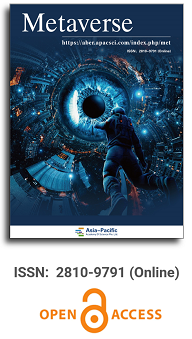
Asia Pacific Academy of Science Pte. Ltd. (APACSCI) specializes in international journal publishing. APACSCI adopts the open access publishing model and provides an important communication bridge for academic groups whose interest fields include engineering, technology, medicine, computer, mathematics, agriculture and forestry, and environment.



The role of generative AI in cyber security
Vol 5, Issue 2, 2024
Download PDF
Abstract
In the ever-evolving landscape of cyber threats, the integration of Artificial Intelligence (AI) has become popular into safeguarding digital assets and sensitive information for organisations throughout the world. This evolution of technology has given rise to a proliferation of cyber threats, necessitating robust cybersecurity measures. Traditional approaches to cybersecurity often struggle to keep pace with these rapidly evolving threats. To address this challenge, Generative Artificial Intelligence (Generative AI) has emerged as a transformative sentinel. Generative AI leverages advanced machine learning techniques to autonomously generate data, text, and solutions, and it holds the potential to revolutionize cybersecurity by enhancing threat detection, incident response, and security decision-making processes. We explore here the pivotal role that Generative AI plays in the realm of cybersecurity, delving into its core concepts, applications, and its potential to shape the future of digital security.
Keywords
References
- Fowler K, Urbanowicz K, Burns M, et al. Cybersecurity threats and incidents differ by region, Deloitte Insights. Available at: https://www2.deloitte.com/us/en/insights/topics/cyber-risk/global-cybersecurity-threat-trends.html (accessed on 3 August 2024).
- Stouffer K, Pease M, Tang C, et al. Guide to Operational Technology (OT) Security. National Institute of Standards and Technology (U.S.); 2023. doi: 10.6028/nist.sp.800-82r3
- Office of Budget Responsibility. The fiscal risks posed by cyberattacks. Available online: https://obr.uk/box/the-fiscal-risks-posed-by-cyberattacks/ (accessed on 3 August 2024).
- Brandl R, Ellis C. ChatGPT Statistics 2024—All the latest statistics about OpenAI’s chatbot. Available online: https://www.tooltester.com/en/blog/chatgpt-statistics/ (accessed on 3 August 2024).
- Petrosyan AP. Number of ransomware attempts per year 2022, Statista. Available online: https://www.statista.com/statistics/494947/ransomware-attempts-per-year-worldwide/ (accessed on 3 August 2024).
- Sun N, Ding M, Jiang J, et al. Cyber Threat Intelligence Mining for Proactive Cybersecurity Defense: A Survey and New Perspectives. IEEE Communications Surveys & Tutorials. 2023; 25(3): 1748-1774. doi: 10.1109/comst.2023.3273282
- Saeed S, Suayyid SA, Al-Ghamdi MS, et al. A Systematic Literature Review on Cyber Threat Intelligence for Organizational Cybersecurity Resilience. Sensors. 2023; 23(16): 7273. doi: 10.3390/s23167273
- Rasel M, Salam MA, & Shovon RB. Synergizing Cyber Threat Intelligence Sharing and Risk Assessment for Enhanced Government Cybersecurity: A Holistic Approach. Journal Environmental Sciences and Technology. 2024; 3(1), 649-673.
- Hasan MK, Weichen Z, Safie N, et al. A Survey on Key Agreement and Authentication Protocol for Internet of Things Application. IEEE Access. 2024; 12: 61642-61666. doi: 10.1109/access.2024.3393567
- Otta SP, Panda S, Gupta M, & Hota C. A systematic survey of multi-factor authentication for cloud infrastructure. Future Internet. 2023; 15(4): 146.
- Frehn J. AI-powered identity authentication is here: What you need to know, Portnox. Available online: https://www.portnox.com/blog/network-security/ai-powered-identity-authentication/ (accessed on 3 August 2024).
- Cheshkov A, Zadorozhny P, & Levichev R. Evaluation of ChatGPT model for vulnerability detection. Available online: https://arxiv.org/abs/2304.07232 (accessed on 3 August 2024).
- Steenhoek B, Rahman MM, Jiles R, & Le W. An empirical study of deep learning models for vulnerability detection. In: 2023 IEEE/ACM 45th International Conference on Software Engineering (ICSE). IEEE; 2023. pp. 2237-2248.
- Curran K, Doherty J, McCann A. Turkington G. Good Practice for Strong Passwords, EDP Audit, Control and Security (EDPACS). Taylor & Francis. 2011; 44(5): 1-13. doi: 10.1080/07366981.2011.635497,
- Curran K, Snodgrass A. A Novel Cue based Picture Word Shape Character Password Creation Scheme. International Journal of Digital Crime and Forensics. 2015; 7(3): 37-59. doi: 10.4018/ijdcf.2015070103
- Umejiaku AP, Dhakal P, Sheng VS. Balancing Password Security and User Convenience: Exploring the Potential of Prompt Models for Password Generation. Electronics. 2023; 12(10): 2159. doi: 10.3390/electronics12102159
- DeBeck C. More organizations saving time and costs on data breaches with automation and ai, Security Intelligence. Available online: https://securityintelligence.com/posts/save-time-money-data-breach-security-ai-automation/ (accessed on 3 August 2024).
- Gregory J. AI reduces data breach lifecycles and costs, Security Intelligence. Available online: https://securityintelligence.com/articles/ai-reduces-data-breach-lifecycles-and-costs/ (accessed on 3 August 2024).
- Bertino E, Kantarcioglu M, Akcora CG, et al. AI for Security and Security for AI. In: Proceedings of the Eleventh ACM Conference on Data and Application Security and Privacy. Association for Computing Machinery, New York, USA. 2021; 333-334.
- Habbal A, Khalif Ali M, Ali Abuzaraid M. Artificial Intelligence Trust, Risk and Security Management (AI TRiSM): Frameworks, applications, challenges and future research directions. Expert Systems with Applications. 2024; 240. doi: 10.1016/j.eswa.2023.122442.
- Bharadiya JP. AI-driven security: how machine learning will shape the future of cybersecurity and web 3.0. American Journal of Neural Networks and Applications. 2023; 9(1): 1-7.
- EU. EU AI Act: first regulation on artificial intelligence. Available online: https://www.europarl.europa.eu/topics/en/article/20230601STO93804/eu-ai-act-first-regulation-on-artificial-intelligence (accessed on 3 August 2024).
- Bain. Generative AI and Cybersecurity: Strengthening Both Defenses and Threats. Available online: https://www.bain.com/insights/generative-ai-and-cybersecurity-strengthening-both-defenses-and-threats-tech-report-2023/ (accessed on 3 August 2024).
- Chamberlain J. The Risk-Based Approach of the European Union’s Proposed Artificial Intelligence Regulation: Some Comments from a Tort Law Perspective. European Journal of Risk Regulation. 2022; 14(1): 1-13. doi: 10.1017/err.2022.38
- Rakha NA. The impacts of Artificial Intelligence (AI) on business and its regulatory challenges. International Journal of Law and Policy. 2023; 1(1).
- Raheman F. The Future of Cybersecurity in the Age of Quantum Computers. Future Internet. 2022; 14(11): 335. doi: 10.3390/fi14110335
- Luo H, Zhang L, Qin H, et al. Beyond universal attack detection for continuous-variable quantum key distribution via deep learning. Physical Review A. 2022; 105(4). doi: 10.1103/physreva.105.042411
- Wang X. Ai-Enhanced Software Vulnerability and Security Patch Analysis (PhD thesis). George Mason University; 2023.
- Hossain Faruk MJ, Shahriar H, Valero M, et al. Malware detection and prevention using Artificial Intelligence Techniques. 2021 IEEE International Conference on Big Data (Big Data). 2021. doi: 10.1109/bigdata52589.2021.9671434.
- Wirkuttis N, and Klein H. Artificial intelligence in cybersecurity. Cyber, Intelligence, and Security. 2017; 1(1): 103-119.
Supporting Agencies
Copyright (c) 2024 Kevin Curran, Ethan Curran, Joseph Killen, Cormac Duffy
License URL: https://creativecommons.org/licenses/by/4.0/

This site is licensed under a Creative Commons Attribution 4.0 International License (CC BY 4.0).

Prof. Zhigeng Pan
Professor, Hangzhou International Innovation Institute (H3I), Beihang University, China

Prof. Jianrong Tan
Academician, Chinese Academy of Engineering, China
Conference Time
December 15-18, 2025
Conference Venue
Hong Kong Convention and Exhibition Center (HKCEC)
...
Metaverse Scientist Forum No.3 was successfully held on April 22, 2025, from 19:00 to 20:30 (Beijing Time)...
We received the Scopus notification on April 19th, confirming that the journal has been successfully indexed by Scopus...
We are pleased to announce that we have updated the requirements for manuscript figures in the submission guidelines. Manuscripts submitted after April 15, 2025 are required to strictly adhere to the change. These updates are aimed at ensuring the highest quality of visual content in our publications and enhancing the overall readability and impact of your research. For more details, please find it in sumissions...






.jpg)
.jpg)

